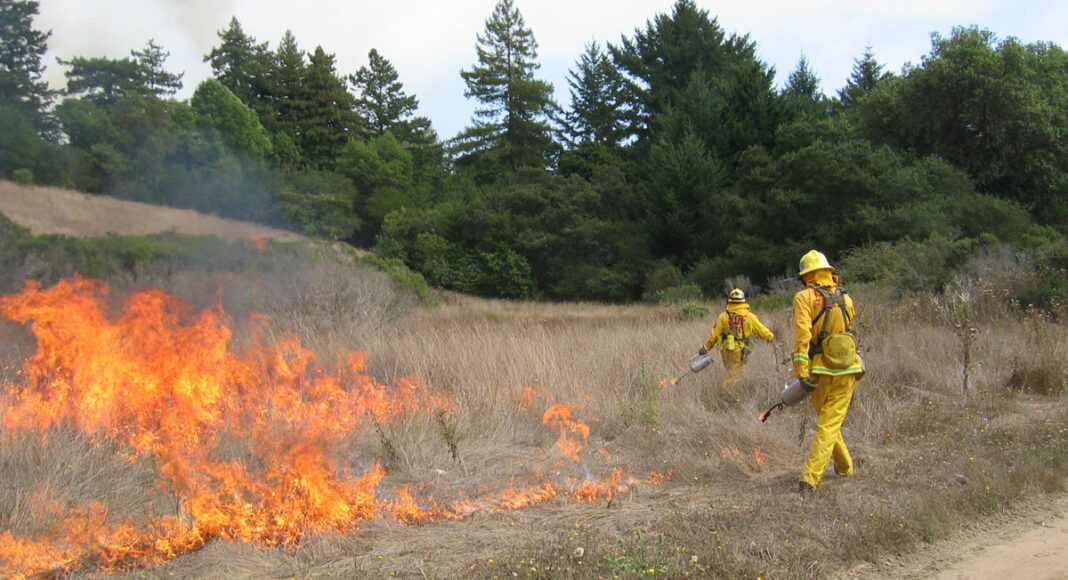The atmosphere at most broadcast prescribed burn sites feels calm and professional. Crews begin arriving early in the morning to check conditions and set up. At a briefing—usually around eight o’clock—the group reviews the prescription and their individual roles.
They conduct a small test fire in the middle of the area. If the fuel burns well, the group sends a request to the regional office for permission to put fire on the ground. The burn itself begins around 10 and runs until mid-afternoon, when the crews begin shutting it down.
A couple of the engines stay behind to patrol the area overnight. The next morning, a smaller group comes back out with foresters to evaluate the area. Once everything has been cold and out for a while, the burn is officially done.
Most controlled burns end without incident. But occasionally, conditions change and things get out of hand. Such was the case at the Estrada Fire in Corralitos in late October.
Wind picked up and sent fire over the lines just as CAL FIRE was starting to shut it down. 148 acres burned before firefighters got the blaze under control.
The unit came under fire on social media for conducting a burn at all on a warm fall day. But Rich Sampson, the Vegetation Management Division Chief for the Santa Cruz County Fire Department, says the day’s conditions fit the bill when they started working.
“Conditions changed,” he says. CAL FIRE critiqued and debriefed after the Estrada fire, but they will not conduct a formal internal review.
“It happens from time to time on fires,” says Sampson. “That’s why we go heavy on the resources.”
There’s a lot of pressure to conduct burns, he says. Millions of acres of land need management to prevent catastrophic wildfires. But conditions must align in just the right way to make it possible.
A narrow window
Air quality, winds, temperature and moisture all determine whether a burn is possible. If conditions are too dry and hot, a fire becomes dangerous. But when the land is too wet, fuel won’t ignite or burn efficiently.
“There is a lot of work that goes into it ahead of time—a lot of environmental review and planning in terms of what will be required in order to implement a burn,” says Angela Bernheisel, CAL FIRE San Mateo-Santa Cruz Unit division chief.
“If anybody thinks it’s just like, we wake up in the morning and say, ‘Oh, I think I’ll just go burn today,’ that’s not how it works,” she says. “There’s a lot of planning and thought that goes into it before any fire ever hits the ground.”
CAL FIRE makes prescriptions for specific plots of land years in advance. When conditions look promising, they choose a plan and start making preparations. But the implementation has to stay flexible.
“We only have about a 25% chance of it actually happening when we plan on it,” says Sampson. Sometimes, the winds change. Other times, resources get pulled to a different fire. At the start of November, a planned week of prescribed fires in Wilder Ranch ended early after rains soaked the brush.
“We’ll make four or five attempts to try to do a burn—say in the fall or in the winter when the conditions are what we want—before it actually happens. Or we have to wait until the next year,” he says.
In recent years, climate change and large wildfires have made it harder to find good windows.
“You need to be in prescription,” says Bernheisel. “So, if climate change is creating conditions that are hotter and drier for longer periods of the year, then it might be more difficult to find that time period when you would be in prescription.”
When conditions do line up, the unit also needs enough people and equipment to manage the fire.
“Because of how bad the fires were this summer around the state, the resources that we had to conduct the fires were gone most of the year on wildland fires,” says Sampson.
“Some years, we just can’t put fire out on the ground because it’s too dry and the field conditions are outside of their prescription or our resources are all gone,” he says. “And so that just pushes more of the pressure to other years, when the conditions are better or resources are available.”
A changing landscape
New developments further complicate matters. Sampson says using fire used to be a “completely different situation.” There were hills where crews could burn a few thousand acres without worrying.
“But now, you go look at some of these areas that used to be vacant, and there’s homes out there,” he says.
“There’s power lines going through areas where it used to be just bare hillsides.”
Fire has existed both as a natural part of the landscape and for management in Santa Cruz County for millennia.
“The ancestors of the Amah Mutsun tribal band were using intentional fire as a tool for many thousands of years,” says Sara French, the director of development at the Amah Mutsun Land Trust.
The Amah Mutsun Land Trust currently works with CAL FIRE on prescribed burns at the Soquel Demonstration State Forest.
CAL FIRE mostly uses prescribed burns in Santa Cruz County to complement or enhance other management strategies, like fuel breaks.
“So we’re not just relying on prescribed burns to do the whole job,” says Bernheisel. “We’re using it as one of the tools to do the job.”
“But conditions are going to continue to get worse and worse,” says Sampson. “The question is, can we put enough on the ground to make a difference and help out? To go ahead and reduce some of the danger?”













